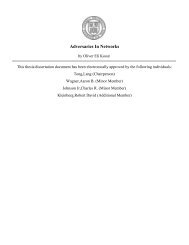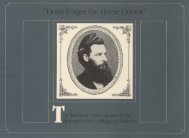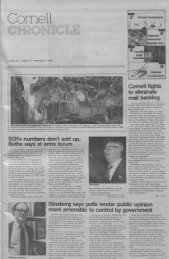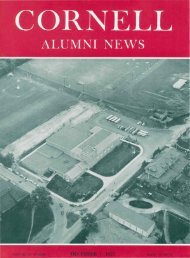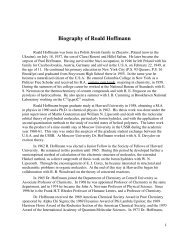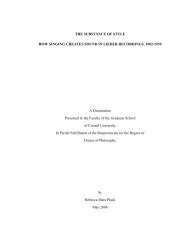Cornell Alumni News - eCommons@Cornell - Cornell University
Cornell Alumni News - eCommons@Cornell - Cornell University
Cornell Alumni News - eCommons@Cornell - Cornell University
You also want an ePaper? Increase the reach of your titles
YUMPU automatically turns print PDFs into web optimized ePapers that Google loves.
the length of the rink to put the Big Red<br />
ahead, 3-0, at 12:41 of the second period.<br />
The Ithacans relaxed momentarily,<br />
however, and Mike Sobeski scored from<br />
two feet out 12 seconds later to put the<br />
Terriers back in range.<br />
<strong>Cornell</strong> was two men down for 1:09<br />
later in the stanza, but BU failed to<br />
score, and it was one man short for five<br />
minutes in the third period, and also<br />
kept Boston from registering, which<br />
seemed to take the starch out of Coach<br />
Jack Kelley's team.<br />
Bob McGuinn iced the verdict at 10:22<br />
of the third period with a rebound goal.<br />
Dry den wound up with 41 saves;<br />
Ryan had 32.<br />
Stanowski, Orr, Doran, and Dryden<br />
made the All-Tourney team, along with<br />
Mike Quinn of Boston <strong>University</strong> and<br />
Tom Mikkola of Michigan State.<br />
Stanowski was named MVP.<br />
It was only the third time in 20 years<br />
an Eastern team has won the NCAA<br />
crown. RPI won in 1954 and Boston<br />
College prevailed in 1949. Coach of the<br />
RPI team was a lad named Ned Harkness.<br />
The eight seniors led <strong>Cornell</strong> to an<br />
over-all record of 68-13-1 in their three<br />
years, a winning percentage of 83.5, including<br />
two Ivy League crowns, one Ivy<br />
runner up, one Eastern title, and one<br />
Eastern runnerup designation.<br />
Harkness arrived at the scene a year<br />
earlier, and his first team was 12-10-1.<br />
The Big Red had shown it meant business<br />
by topping North Dakota, 1-0, in<br />
the semifinals March 16.<br />
North Dakota was champion of the<br />
tough Western Conference Hockey Assn.,<br />
and had considerable speed. It did a most<br />
effective job on the Big Red's offense.<br />
The game was a tight defensive struggle<br />
throughout, with a goal by heroic Skip<br />
Stanowski at 17:27 of the first period<br />
the only score.<br />
Ken Dryden posted a shutout, first in<br />
NCAA title-play history.<br />
Stanowski scored his goal 10 seconds<br />
after coming out of the penalty box,<br />
where he had been sent at 15:17 for<br />
boarding.<br />
Fencing<br />
Don Sieja '68 of Princeton, N.J., won<br />
the Illinois Memorial Award as Ail-<br />
American fencer of 1967 at the NCAAs<br />
at Northridge, Calif.<br />
He placed fifth in the epee to lead the<br />
Big Red to a sixth place finish in the<br />
37-team field.<br />
Other <strong>Cornell</strong> finishers were Dave<br />
Ross '67 of New York, 16th, foil; and<br />
Mike Marion '68 of Boston, Mass., 12th,<br />
sabre.<br />
Wrestling<br />
Don New '67 of Canastota placed<br />
fifth in the NCAA 137-pound division at<br />
Kent, Ohio.<br />
He lost, 5-2, in the quarterfinals to<br />
Masaru Yatable of Portland State, who<br />
Undergraduate Report<br />
bowed in the finals in overtime to Michigan<br />
State's Dale Anderson.<br />
Bob Stock '67 of Bellemare lost in<br />
the 130-pound quarterfinals to Oklahoma's<br />
Harold McGuire in overtime,<br />
and the Sooner went on to win the<br />
NCAA title.<br />
<strong>Cornell</strong> was in a three-way tie for<br />
24th place with 8 points. Michigan State<br />
won with 74.<br />
The Disadvantaged<br />
BY SETH S. GOLDSCHLAGER '68<br />
• Who is really "culturally disadvantaged?"<br />
Is it the Negro student who doesn't<br />
come from the suburban split-level with<br />
the two cars? Or is it the white student<br />
who has never been taught the achievements<br />
of most black historical figures?<br />
These are the kinds of questions that<br />
are just now beginning to stir the<br />
thoughts of faculty, students, and administrators<br />
within the <strong>Cornell</strong> community.<br />
They stem from the presence on<br />
campus of more than a token number of<br />
Negro students. And they are the types<br />
of questions the entire white society of<br />
this nation may be pondering if integration—of<br />
true equals—is to have meaning<br />
for both whites and Negroes.<br />
The wondering aloud that's beginning<br />
to be heard characterizes what is termed<br />
"the new mood of the Negro students"<br />
on campus. That phrase is used in a<br />
progress report of the <strong>Cornell</strong> Committee<br />
on Special Educational Projects. The<br />
group was set up in 1963 with a mandate<br />
from President James A. Perkins<br />
to develop "new programs through<br />
which <strong>Cornell</strong> could make a larger contribution<br />
to the education of qualified<br />
students who have been disadvantaged by<br />
their cultural, economic, and educational<br />
environments."<br />
The President's committee reflected the<br />
impact of the civil rights movement of<br />
the late '50s. Suddenly, <strong>Cornell</strong> looked at<br />
its own posture in regard to equal opportunity<br />
in education and found that<br />
while there existed no overt racial barriers<br />
to prospective students, this open<br />
door was not enough. For, as the special<br />
committee soon discovered, certain students,<br />
many of them Negro, could not<br />
meet the admissions standards of the<br />
college although they may have had the<br />
innate ability to do well at <strong>Cornell</strong>.<br />
The real problem, it was found, lay in<br />
poor elementary-through-high school<br />
educations, culturally biased standardized<br />
tests, and lack of funds to support<br />
the students. While the well prepared and<br />
well endowed Negro student could go to<br />
just about any school, the "disadvantaged"<br />
students were being denied an<br />
education more because of their environment<br />
than because of their will and<br />
abilities.<br />
The committee's work in recruiting,<br />
supporting, and aiding ninety-five academically<br />
"marginal" students over the<br />
past three years is documented in the<br />
group's short but important report<br />
issued this year. It shows that while<br />
half the students in the program attend<br />
the College of Arts & Sciences, every<br />
school except Architecture has enrolled<br />
at least one of the students the past two<br />
years. Besides Arts, the bulk of the group<br />
is concentrated in the College of Agriculture<br />
and the Engineering college. The<br />
students are active in campus activities<br />
and many work at campus jobs to support<br />
themselves. Some have pledged<br />
fraternities and sororities.<br />
"Progress" to this committee might<br />
seem the reverse of normal college admission<br />
officers' statements. For, as evidence<br />
that the truly "marginal" students<br />
are being enrolled, the committee cites<br />
May 1967 41




